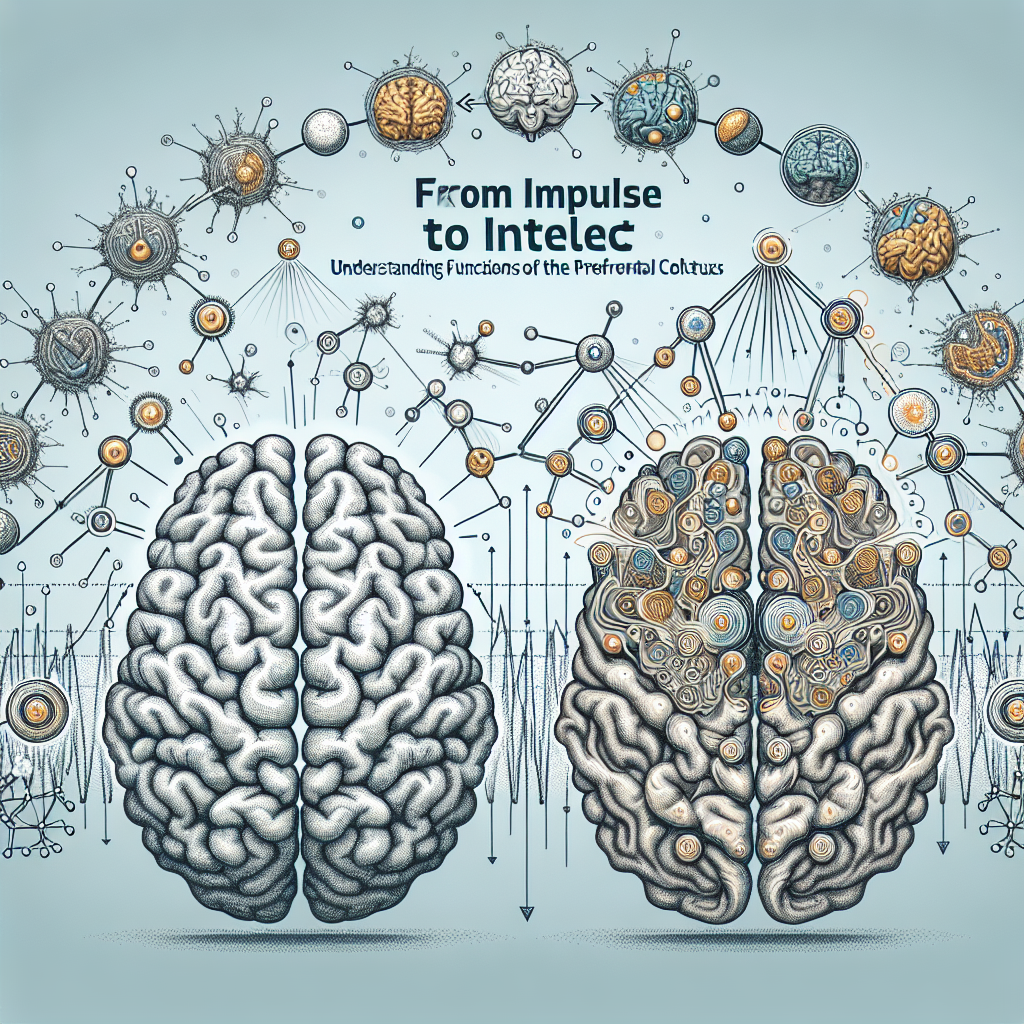
Introduction
Imagine a world where every decision you make is perfectly reasoned, every impulse carefully measured, and every action fully intentional. This ideal state may seem remote, yet it is driven by a remarkable and complex region of the brain known as the prefrontal cortex (PFC). This article, "From Impulse to Intellect: Understanding the Functions of the Prefrontal Cortex," delves into the multifaceted functions of the PFC, its role in decision-making, and how it shapes our behaviors and personalities.
The PFC is the seat of executive functions—those higher-order cognitive processes that help us manage our thoughts, emotions, and actions. Understanding this brain region reveals not just the intricacies of human behavior but also opportunities for growth, improvement, and enhanced decision-making. With advances in neuroscience, we can appreciate how this brain area fosters our evolution from mere responders to calculated thinkers.
Let us embark on this enlightening journey to uncover how the prefrontal cortex bridges the gap from impulse to intellect.
What is the Prefrontal Cortex?
The prefrontal cortex is located at the front of the frontal lobes and is one of the last areas of the brain to mature, often continuing to develop until the mid-twenties. Structurally, it is comprised of several key regions: the dorsolateral prefrontal cortex (DLPFC), ventromedial prefrontal cortex (VMPFC), orbitofrontal cortex (OFC), and anterior cingulate cortex (ACC). Each of these areas contributes to distinct cognitive functions:
- Dorsolateral Prefrontal Cortex (DLPFC): Involved in working memory, rational decision-making, and planning.
- Ventromedial Prefrontal Cortex (VMPFC): Plays a vital role in emotion regulation and value-based decision-making.
- Orbitofrontal Cortex (OFC): Assists in evaluating rewards and consequences which influences decision-making.
- Anterior Cingulate Cortex (ACC): Integral for emotional regulation and error detection.
These functions together contribute to a range of human experiences, shaping how we react to situations and ultimately guiding our behavior.
The Journey from Impulse to Intellect
1. Understanding Impulse Control
At its core, impulse control stems from the ability of the prefrontal cortex to regulate emotions and restrain automatic responses. Impulsivity is often linked to the underdevelopment or dysfunction of the PFC. For instance, children and adolescents exhibit higher levels of impulsivity as their PFC is still maturing. This developmental delay explains many of the risky behaviors observed during teenage years.
Case Study: The Teen Brain
A study conducted by Steinberg (2007) on adolescents highlighted this dynamic beautifully. The research demonstrated that teens often perform poorly on decision-making tasks when peers are present, suggesting that social influences can overpower prefrontal function, leading to impulsive behaviors. The implication is profound: understanding this can guide approaches in education and parenting.
2. Executive Functions: The Brain’s Command Center
The PFC is primarily responsible for managing executive functions. These functions include cognitive processes such as planning, organization, attention, and problem-solving—all essential ingredients for mature thought and action.
Table 1: Executive Functions and Their Impacts
| Function | Description | Impact on Behavior |
|---|---|---|
| Planning | Ability to plan for future tasks | Better academic and work performance |
| Organization | Systematic arrangement of thoughts and actions | Improved time management and efficiency |
| Attention | Focusing on relevant stimuli | Enhanced learning and retention |
| Problem Solving | Evaluating solutions and making decisions | More effective conflict resolution |
By utilizing these executive functions, individuals transition from immediate responses to more reflective, reasoned actions.
3. Emotional Regulation: The Balancing Act
Emotional regulation is another critical aspect of the PFC’s functionality. The brain region plays a significant role in modulating our emotions and reactions to stress. Enhanced emotional regulation contributes to better interpersonal relationships and well-being.
Case Study: Stress and Emotion Regulation
Research by Gross et al. (2005) shows that individuals with a highly active prefrontal cortex exhibit better emotional regulation in stressful situations. Their ability to reflect before reacting helps them navigate complex social dynamics more effectively. The findings emphasize the essential role of the PFC in fostering resilience and emotional intelligence.
4. Decision Making: Weighing Risks and Rewards
One of the most accessible applications of prefrontal cortex functionality is its role in decision-making. The PFC helps evaluate risks, predict outcomes, and make value-based choices.
Case Study: Moral Decision Making
A fascinating study published in the journal Nature investigated how individuals make moral decisions. Participants faced dilemmas where they had to choose between self-interest and altruism. Brain imaging revealed increased activity in the DLPFC during these moral dilemmas, indicating its involvement in weighing the consequences of their choices.
5. Implications of PFC Dysfunction
Dysfunction in the prefrontal cortex can lead to various challenges, including impulsivity, poor emotional regulation, and impaired decision-making. Conditions such as ADHD, OCD, and substance use disorders demonstrate how PFC irregularities can severely impact life outcomes.
Table 2: Conditions Linked to PFC Dysfunction
| Condition | Common Symptoms | Possible Interventions |
|---|---|---|
| ADHD | Impulsivity, distractibility | Behavioral therapy, medication |
| OCD | Intrusive thoughts, compulsive behaviors | Cognitive-behavioral therapy (CBT) |
| Substance Use Disorder | Impaired judgment, impulsivity | Integrated treatment strategies |
6. Enhancing Prefrontal Cortex Functions
Understanding the PFC’s functions opens up pathways for personal growth. Here are several strategies to enhance PFC capabilities:
-
Mindfulness Practices: Engaging in mindfulness meditation can strengthen emotional regulation and decision-making by increasing the brain’s neuronal connectivity.
-
Cognitive Training: Activities such as puzzles and strategy games can enhance problem-solving abilities and executive functions.
- Physical Exercise: Regular physical activity promotes brain health and has been shown to enhance cognitive flexibility and decision-making.
Conclusion
From impulsive reactions to intellectual deliberation, the journey of human cognition is intricately linked to the functionalities of the prefrontal cortex. As we have explored, understanding the PFC enables us to better navigate our thoughts, emotions, and decisions. It serves as a reminder that our capability to evolve from impulse to intellect is grounded in the biology of our brains.
By embracing mindfulness, cognitive training, and healthy lifestyles, we can harness the power of the prefrontal cortex, enhancing our decision-making abilities and emotional resilience. The journey from impulse to intellect is not just a personal odyssey but a universal quest, one that can profoundly enhance our lives.
FAQs
1. What is the primary function of the prefrontal cortex?
The primary function of the prefrontal cortex is to manage executive functions, including decision-making, planning, emotional regulation, and impulse control.
2. How does the prefrontal cortex develop over time?
The prefrontal cortex is one of the last brain regions to mature, often continuing to develop until an individual reaches their mid-twenties.
3. What happens if the prefrontal cortex is damaged?
Damage to the PFC can result in various cognitive and emotional impairments, including impulsivity, poor decision-making, and difficulties in emotional regulation.
4. Can I improve my prefrontal cortex functions?
Yes! Engaging in mindfulness practices, cognitive training, and regular physical activity can help improve the functioning of the prefrontal cortex.
5. What are some disorders related to prefrontal cortex dysfunction?
Conditions such as ADHD, OCD, and substance use disorders often involve dysfunction in the prefrontal cortex. Treatment may involve cognitive-behavioral therapy or medications.
In conclusion, "From Impulse to Intellect: Understanding the Functions of the Prefrontal Cortex" unravels the transformative power of this remarkable brain region. Armed with this knowledge, individuals can make conscious efforts toward enhancing their cognitive capabilities, asserting greater control over their lives.


















